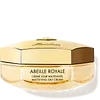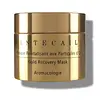What's inside
What's inside
 Key Ingredients
Key Ingredients

 Benefits
Benefits

 Concerns
Concerns

 Ingredients Side-by-side
Ingredients Side-by-side

Water
Skin ConditioningGlycerin
HumectantPropanediol
SolventC15-19 Alkane
SolventIsononyl Isononanoate
EmollientMel
EmollientJojoba Esters
EmollientGlyceryl Stearate
EmollientPEG-100 Stearate
Cellulose
AbsorbentAmmonium Acryloyldimethyltaurate/Vp Copolymer
Cetyl Alcohol
EmollientDimethicone
EmollientStearyl Alcohol
EmollientRoyal Jelly
Phenoxyethanol
PreservativeAscorbyl Glucoside
AntioxidantCaprylyl Glycol
EmollientSteareth-21
CleansingParfum
MaskingButyrospermum Parkii Butter
Skin ConditioningAcrylates/C10-30 Alkyl Acrylate Crosspolymer
Emulsion StabilisingAvena Sativa Kernel Extract
AbrasiveTocopheryl Acetate
AntioxidantXanthan Gum
EmulsifyingSodium Hydroxide
BufferingTetrasodium EDTA
Glyceryl Polymethacrylate
Centella Asiatica Leaf Extract
Skin ConditioningSodium Hyaluronate
HumectantGlycyrrhiza Glabra Root Extract
BleachingPEG-8
HumectantTocopherol
AntioxidantSodium Benzoate
MaskingHyaluronic Acid
HumectantButylene Glycol
HumectantSodium Lactate
BufferingZingiber Officinale Root Extract
MaskingBHT
AntioxidantPalmitoyl Hexapeptide-12
Skin ConditioningCitric Acid
BufferingWater, Glycerin, Propanediol, C15-19 Alkane, Isononyl Isononanoate, Mel, Jojoba Esters, Glyceryl Stearate, PEG-100 Stearate, Cellulose, Ammonium Acryloyldimethyltaurate/Vp Copolymer, Cetyl Alcohol, Dimethicone, Stearyl Alcohol, Royal Jelly, Phenoxyethanol, Ascorbyl Glucoside, Caprylyl Glycol, Steareth-21, Parfum, Butyrospermum Parkii Butter, Acrylates/C10-30 Alkyl Acrylate Crosspolymer, Avena Sativa Kernel Extract, Tocopheryl Acetate, Xanthan Gum, Sodium Hydroxide, Tetrasodium EDTA, Glyceryl Polymethacrylate, Centella Asiatica Leaf Extract, Sodium Hyaluronate, Glycyrrhiza Glabra Root Extract, PEG-8, Tocopherol, Sodium Benzoate, Hyaluronic Acid, Butylene Glycol, Sodium Lactate, Zingiber Officinale Root Extract, BHT, Palmitoyl Hexapeptide-12, Citric Acid
Rosa Damascena Flower Water
MaskingGlycerin
HumectantWater
Skin ConditioningCetearyl Alcohol
EmollientSimmondsia Chinensis Seed Oil
EmollientLactococcus Ferment Lysate
Skin ConditioningOctyldodecanol
EmollientButyrospermum Parkii Butter
Skin ConditioningPentaerythrityl Tetraethylhexanoate
EmollientTrehalose
HumectantCetyl Alcohol
EmollientCocos Nucifera Oil
MaskingSodium Polyacrylate
AbsorbentGlyceryl Stearate
EmollientSesamum Indicum Seed Oil
EmollientSorbitol
HumectantHydrogenated Polydecene
EmollientCI 77891
Cosmetic ColorantRibes Nigrum Seed Oil
EmollientXanthan Gum
EmulsifyingDicaprylyl Carbonate
EmollientSteareth-21
CleansingEthylhexylglycerin
Skin ConditioningAstrocaryum Murumuru Seed Butter
EmollientDunaliella Salina Extract
Skin ConditioningTrideceth-6
EmulsifyingLinum Usitatissimum Seed Oil
PerfumingSodium Phytate
Pentylene Glycol
Skin ConditioningHelianthus Annuus Seed Oil Unsaponifiables
EmollientSilica
AbrasiveTocopherol
AntioxidantHelianthus Annuus Seed Oil
EmollientRosa Damascena Flower Oil
MaskingPelargonium Graveolens Oil
MaskingLactic Acid
BufferingSodium Hyaluronate
HumectantCardiospermum Halicacabum Flower/Leaf/Vine Extract
Skin ConditioningRosmarinus Officinalis Leaf Extract
AntimicrobialNicotiana Sylvestris Leaf Cell Culture
Skin ConditioningAcetyl Tetrapeptide-2
Skin ConditioningN-Prolyl Palmitoyl Tripeptide-56 Acetate
Skin ConditioningBenzyl Alcohol
PerfumingGlyceryl Caprylate
EmollientBenzoic Acid
MaskingPropanediol
SolventSodium Benzoate
MaskingMica
Cosmetic ColorantColloidal Gold
AntimicrobialAcetyl Heptapeptide-9
Skin ConditioningCI 77491
Cosmetic ColorantPhenoxyethanol
PreservativeCaprylyl Glycol
EmollientSodium Chloride
MaskingPotassium Sorbate
PreservativeChlorphenesin
AntimicrobialCitronellol
PerfumingGeraniol
PerfumingLinalool
PerfumingCitral
PerfumingFarnesol
PerfumingRosa Damascena Flower Water, Glycerin, Water, Cetearyl Alcohol, Simmondsia Chinensis Seed Oil, Lactococcus Ferment Lysate, Octyldodecanol, Butyrospermum Parkii Butter, Pentaerythrityl Tetraethylhexanoate, Trehalose, Cetyl Alcohol, Cocos Nucifera Oil, Sodium Polyacrylate, Glyceryl Stearate, Sesamum Indicum Seed Oil, Sorbitol, Hydrogenated Polydecene, CI 77891, Ribes Nigrum Seed Oil, Xanthan Gum, Dicaprylyl Carbonate, Steareth-21, Ethylhexylglycerin, Astrocaryum Murumuru Seed Butter, Dunaliella Salina Extract, Trideceth-6, Linum Usitatissimum Seed Oil, Sodium Phytate, Pentylene Glycol, Helianthus Annuus Seed Oil Unsaponifiables, Silica, Tocopherol, Helianthus Annuus Seed Oil, Rosa Damascena Flower Oil, Pelargonium Graveolens Oil, Lactic Acid, Sodium Hyaluronate, Cardiospermum Halicacabum Flower/Leaf/Vine Extract, Rosmarinus Officinalis Leaf Extract, Nicotiana Sylvestris Leaf Cell Culture, Acetyl Tetrapeptide-2, N-Prolyl Palmitoyl Tripeptide-56 Acetate, Benzyl Alcohol, Glyceryl Caprylate, Benzoic Acid, Propanediol, Sodium Benzoate, Mica, Colloidal Gold, Acetyl Heptapeptide-9, CI 77491, Phenoxyethanol, Caprylyl Glycol, Sodium Chloride, Potassium Sorbate, Chlorphenesin, Citronellol, Geraniol, Linalool, Citral, Farnesol
Ingredients Explained
These ingredients are found in both products.
Ingredients higher up in an ingredient list are typically present in a larger amount.
This ingredient is also known as shea butter. It is an effective skin hydrator and emollient.
Emollients help soothe and soften your skin. It does this by creating a protective film on your skin. This barrier helps trap moisture and keeps your skin hydrated. Emollients may be effective at treating dry or itchy skin.
Shea butter is rich in antioxidants. Antioxidants help fight free-radicals, or molecules that may harm the body. It is also full of fatty acids including stearic acid and linoleic acid. These acids help replenish the skin and keep skin moisturized.
While Shea Butter has an SPF rating of about 3-4, it is not a sunscreen replacement.
Shea butter may not be fungal acne safe. We recommend speaking with a professional if you have any concerns.
Learn more about Butyrospermum Parkii ButterCaprylyl Glycol is a humectant and emollient, meaning it attracts and preserves moisture.
It is a common ingredient in many products, especially those designed to hydrate skin. The primary benefits are retaining moisture, skin softening, and promoting a healthy skin barrier.
Though Caprylyl Glycol is an alcohol derived from fatty acids, it is not the kind that can dry out skin.
This ingredient is also used as a preservative to extend the life of products. It has slight antimicrobial properties.
Learn more about Caprylyl GlycolCetyl Alcohol is a fatty alcohol. Fatty Alcohols are most often used as an emollient or to thicken a product.
Its main roles are:
Though it has "alcohol" in the name, it is not related to denatured alcohol or ethyl alcohol.
The FDA allows products labeled "alcohol-free" to have fatty alcohols.
Learn more about Cetyl AlcoholGlycerin is already naturally found in your skin. It helps moisturize and protect your skin.
A study from 2016 found glycerin to be more effective as a humectant than AHAs and hyaluronic acid.
As a humectant, it helps the skin stay hydrated by pulling moisture to your skin. The low molecular weight of glycerin allows it to pull moisture into the deeper layers of your skin.
Hydrated skin improves your skin barrier; Your skin barrier helps protect against irritants and bacteria.
Glycerin has also been found to have antimicrobial and antiviral properties. Due to these properties, glycerin is often used in wound and burn treatments.
In cosmetics, glycerin is usually derived from plants such as soybean or palm. However, it can also be sourced from animals, such as tallow or animal fat.
This ingredient is organic, colorless, odorless, and non-toxic.
Glycerin is the name for this ingredient in American English. British English uses Glycerol/Glycerine.
Learn more about GlycerinGlyceryl Stearate is a mix of glycerin and stearic acid.
It is used to stabilize the mixing of water and oil ingredients. By preventing these ingredients from separating, it can help elongate shelf life. It can also help thicken the product's texture.
As an emollient, it helps soften skin and supports barrier-replenishing ingredients.
In cosmetics, Glyceryl Stearate is often made from vegetable oils or synthetically produced.
This ingredient may not be fungal-acne safe
Fun fact: The human body also creates Glyceryl Stearate naturally.
Learn more about Glyceryl StearatePhenoxyethanol is a preservative that has germicide, antimicrobial, and aromatic properties. Studies show that phenoxyethanol can prevent microbial growth. By itself, it has a scent that is similar to that of a rose.
It's often used in formulations along with Caprylyl Glycol to preserve the shelf life of products.
Propanediol is an all-star ingredient. It softens, hydrates, and smooths the skin.
It’s often used to:
Propanediol is not likely to cause sensitivity and considered safe to use. It is derived from corn or petroleum with a clear color and no scent.
Learn more about PropanediolSodium Benzoate is a preservative. It's used in both cosmetic and food products to inhibit the growth of mold and bacteria. It is typically produced synthetically.
Both the US FDA and EU Health Committee have approved the use of sodium benzoate. In the US, levels of 0.1% (of the total product) are allowed.
Sodium benzoate works as a preservative by inhibiting the growth of bacteria inside of cells. It prevents the cell from fermenting a type of sugar using an enzyme called phosphofructokinase.
It is the salt of benzoic acid. Foods containing sodium benzoate include soda, salad dressings, condiments, fruit juices, wines, and snack foods.
Studies for using ascorbic acid and sodium benzoate in cosmetics are lacking, especially in skincare routines with multiple steps.
We always recommend speaking with a professional, such as a dermatologist, if you have any concerns.
Learn more about Sodium BenzoateSodium Hyaluronate is hyaluronic acid's salt form. It is commonly derived from the sodium salt of hyaluronic acid.
Like hyaluronic acid, it is great at holding water and acts as a humectant. This makes it a great skin hydrating ingredient.
Sodium Hyaluronate is naturally occurring in our bodies and is mostly found in eye fluid and joints.
These are some other common types of Hyaluronic Acid:
Learn more about Sodium HyaluronateWe don't have a description for Steareth-21 yet.
Tocopherol (also known as Vitamin E) is a common antioxidant used to help protect the skin from free-radicals and strengthen the skin barrier. It's also fat soluble - this means our skin is great at absorbing it.
Vitamin E also helps keep your natural skin lipids healthy. Your lipid skin barrier naturally consists of lipids, ceramides, and fatty acids. Vitamin E offers extra protection for your skin’s lipid barrier, keeping your skin healthy and nourished.
Another benefit is a bit of UV protection. Vitamin E helps reduce the damage caused by UVB rays. (It should not replace your sunscreen). Combining it with Vitamin C can decrease sunburned cells and hyperpigmentation after UV exposure.
You might have noticed Vitamin E + C often paired together. This is because it is great at stabilizing Vitamin C. Using the two together helps increase the effectiveness of both ingredients.
There are often claims that Vitamin E can reduce/prevent scarring, but these claims haven't been confirmed by scientific research.
Learn more about TocopherolWater. It's the most common cosmetic ingredient of all. You'll usually see it at the top of ingredient lists, meaning that it makes up the largest part of the product.
So why is it so popular? Water most often acts as a solvent - this means that it helps dissolve other ingredients into the formulation.
You'll also recognize water as that liquid we all need to stay alive. If you see this, drink a glass of water. Stay hydrated!
Learn more about WaterXanthan gum is used as a stabilizer and thickener within cosmetic products. It helps give products a sticky, thick feeling - preventing them from being too runny.
On the technical side of things, xanthan gum is a polysaccharide - a combination consisting of multiple sugar molecules bonded together.
Xanthan gum is a pretty common and great ingredient. It is a natural, non-toxic, non-irritating ingredient that is also commonly used in food products.
Learn more about Xanthan Gum